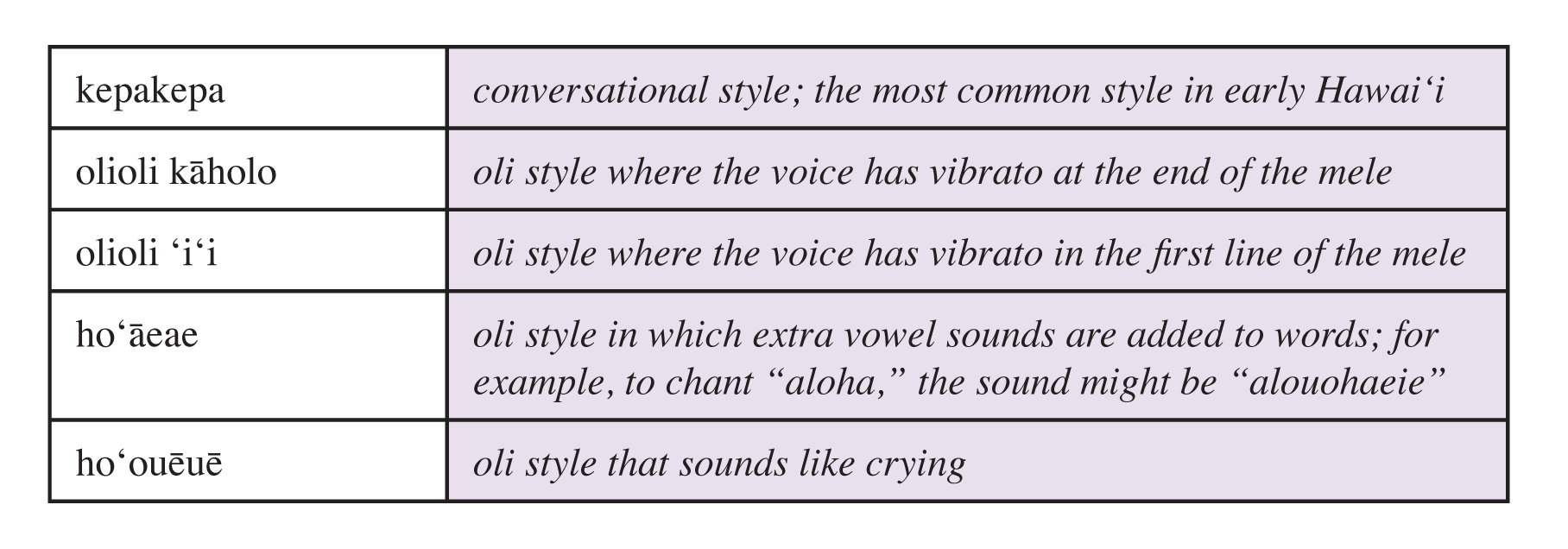Oli— ʻŌlelo Noʻeau #67Aia nō i ka mea e mele ana.Let the singer select the song.
![[Miss Aloha Hula Competition] Lilinoe Sterling on the Kahiko night of the Merrie Monarch Miss Aloha Hula Competition, 2012. Photo by Albert Cardamon.](/unit-assets/04_oli.jpg) Is there a special someone you’ve got your eye on? Maybe oli is the way to show your feelings. Do you have a prayer request? Maybe oli is the way to send that request.
Is there a special someone you’ve got your eye on? Maybe oli is the way to show your feelings. Do you have a prayer request? Maybe oli is the way to send that request.
This is how things were done in early Hawai‘i. There was no singing. Oli, or chanting, was the way that mele, songs or poems, were presented.
Just as we can all sing today (whether or not it’s the best singing), early Hawaiians could all chant. The most skilled chanting was described like this: “The voice is soft like a breeze; the vibrato is strong in the throat; the voice purrs at the base of the ear; the sound gurgles at the base of the uvula; breathing is gentle in the chest, which rises and falls; the breath vibrates to the tip of the tongue; the jaws and mouth are open wide; the blood vessels are not bulging with strain” (Kamakau 1996, 238).
![[Hawaiian chanter] Kuluwaimaka; Hawaiʻi, ca. 1930. Photo by Ray Jerome Baker.](/unit-assets/01_oli.jpg)
In early Hawai‘i, as well as today, oli thrives in all aspects of our culture. Mele and oli are central in hula. They are also very important in daily Hawaiian life. Mele are chanted to our gods, to our kūpuna, to our people, and to our ‘āina. Oli is one way we communicate with everything in the world around us.
Our voice is very important. When visiting someone’s home, we might give a mele as a ho‘okupu, or gift, to the hosts. The voice is also one of the requirements to gain entry into a new place or into a hālau hula, or hula school. When Hi‘iaka and her entourage were traveling by canoe, she would oli her greetings to people and places as she passed by. So mele is a way to show our aloha.
![[Hula dancers and chanter] Hawaiʻi, ca. 1880. Photo by H. L. Chase.](/unit-assets/02_oli.jpg)
Oli come in many different forms. The type of mele determines the style of oli to use. For mele inoa, we might use the oli kepakepa style, the olioli kāholo style, or the olioli ‘i‘i style. For mele aloha, we might use the oli ho‘āeae style. For mele kanikau, we might use the oli ho‘ouēuē style. There are many more types of mele, and there are many more styles of oli. Here is a short listing of certain styles of oli:

A skilled chanter’s voice can have many unique features. The ‘i‘i is a special tremor, or shaking, of the voice. The ‘i‘i ho‘ānu‘unu‘u is when the voice shakes rhythmically. These are just a couple of the many ways chanters can make their voice more interesting.
![[Hula dancers] Photo by Carlton Abas.](/unit-assets/03_oli.jpg)
Today, like long ago, we have famous chanters and composers of mele. Some of them are skilled at both chanting and composing. A composer is recognized with the “song of the year” award at Nā Hōkū Hanohano (the foremost awards show for Hawaiian and local music). There is also an award for best chanter at the King Kamehameha Hula Competition.
Oli is not the only way for a mele to be heard. From the time the missionaries arrived, we would also sing. Oli is different from singing. Some characteristics of oli, however, are present in the voices of certain contemporary Hawaiian music artists.
Just as there are countless subjects for which a mele may be written, there is no end to the venues in which to oli. You can chant when you wake up, when you cruise in your car, when you bathe, and when you play. Anytime! Whenever you chant, the world will listen.
![[Hula dancer chanting outside] Photo by Ruben Carillo.](/unit-assets/05_oli.jpg)
ʻŌlelo noʻeau related to oli
‘A‘ohe i mane‘o iho ke kumu pepeiao i kāu hīmeni. (‘Ōlelo No‘eau #150)
Even the base of the ear isn’t tickled by your song.
A rude remark to one whose song or story is not appealing.
Hele ‘ē ka pila, hele ‘ē ka leo. (‘Ōlelo No‘eau #735)
The music is in one pitch and the voice in another.
Said of a lack of harmony.
I le‘a ka hula i ka ho‘opa‘a. (‘Ōlelo No‘eau #1225)
The hula is pleasing because of the drummer.
Although the attention is given to the dancer, the drummer and chanter play an important role in the dance.
